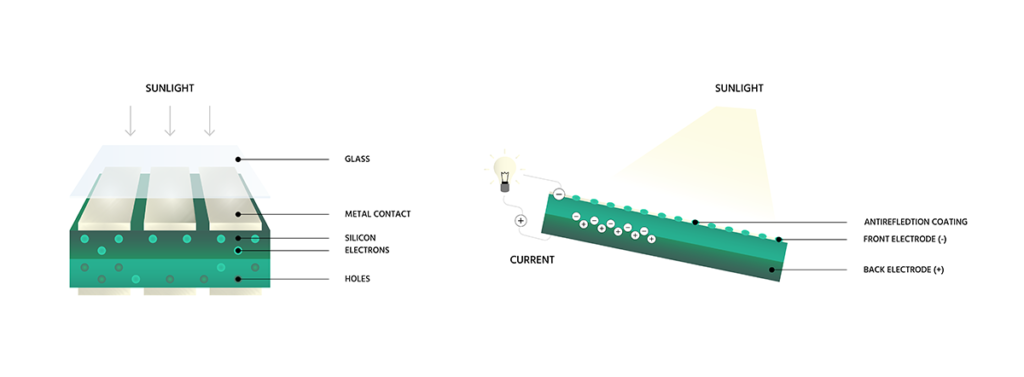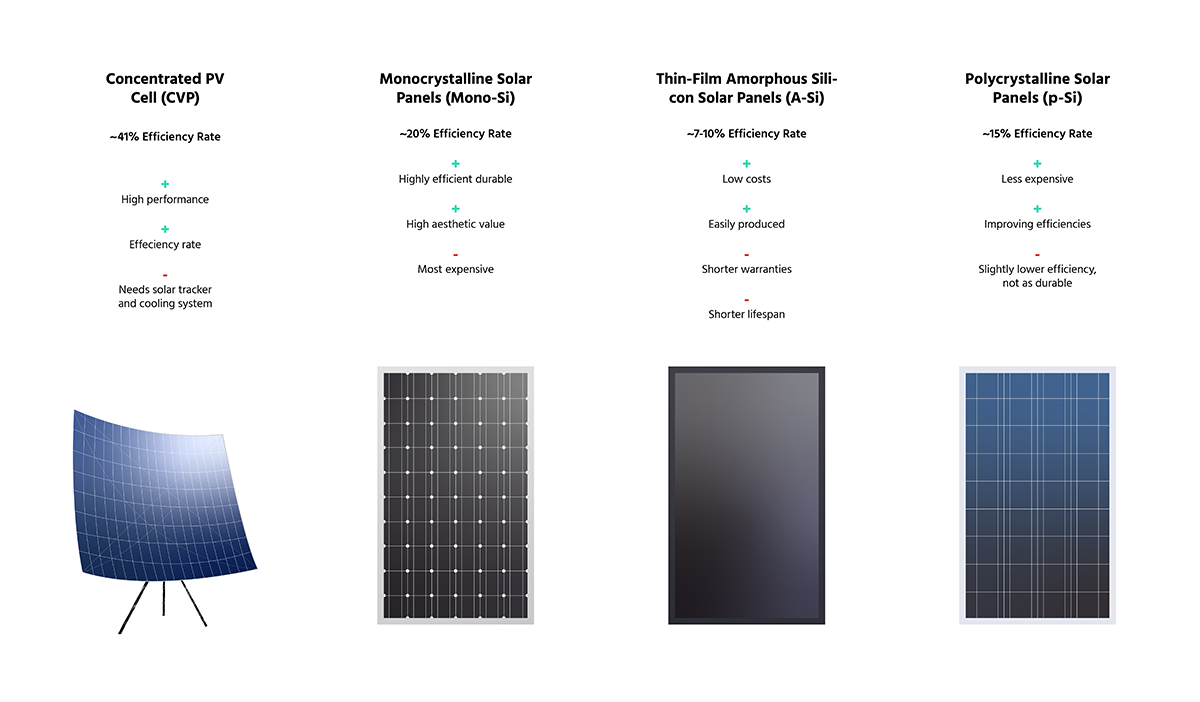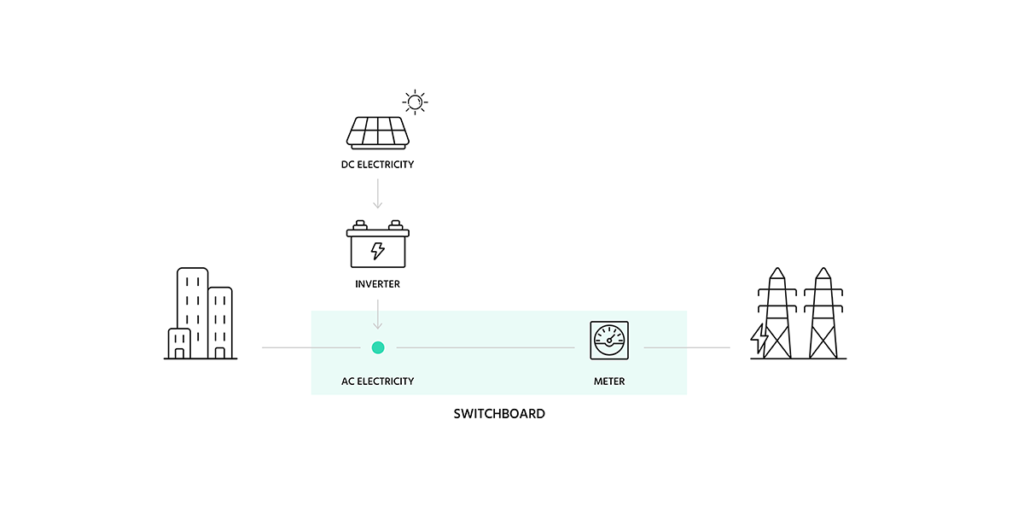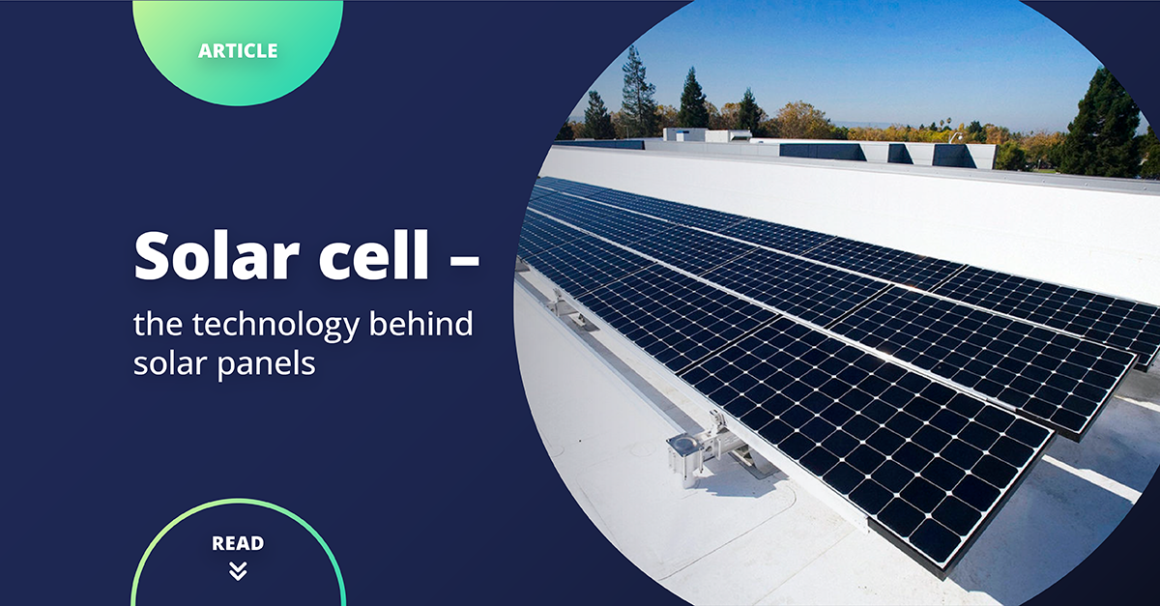Solar cells - the physical phenomenon in power generation
Photovoltaic cells are unique power generators. The biggest difference between solar panels and batteries or fuel cells is that they don’t require any chemical reactions or fuel to produce or store electric energy – only sunlight. The other significant distinction is that, unlike electric generators, solar cells do not have any moving parts.
A solar cell, also called a photovoltaic cell, is an electronic device that converts the light into electrical energy through a photovoltaic effect. It is a physical phenomenon, but we can split it into three basic steps to understand how sunlight is converted into usable electricity by solar cells in solar panels.
Three general processes in a solar photovoltaic (PV) cell:
- Light absorption generates carriers (knocked-out loose electrons)
- Carriers flow, creating power
- Energy is captured and transferred to wires

Each photovoltaic circuit consists of two silicon semiconductors: one positively charged (p-type), the other negatively charged (n-type). The smallest unit of the light – photon is always absorbed by an n-type semiconductor. It generates the movement of higher-energy electrons from the solar cell into an external circuit. The electrons then dissipate their energy in the external circuit and return to the solar cell.
Silicon solar cell may be called a p-n junction diode, although its construction is quite different from conventional p-n junction diodes. They’re a form of a photovoltaic PV cell, defined as a device with electrical characteristics – such as current, voltage, or resistance. Solar cells’ abilities and efficiency vary when in contact with light.
Solar cells are the fundamental part of solar panels
Individual solar cells can be combined to form modules commonly referred to as solar cell panels or simply solar panels. Homeowners install them on their rooftops to replace, augment, or increase their conventional electricity supply efficiency. The standard single-junction photovoltaic cell can generate a maximum open-circuit voltage of about 0.5 to 0.6 volts. It may not seem as much power – but these solar cells are extremely tiny and efficient. When thousands of silicon solar cells are combined into a conventional solar panel, significant amounts of renewable energy can be generated.
Solar Panels can also be arranged into extensive groupings – arrays. Arrays are significantly bigger than regular solar panels used on family households. These arrangements, composed of hundreds of thousands of individual photovoltaic cells, play the central electric power station’s role, converting the sunlight into electrical energy used for industrial, commercial, or residential purposes.
HOW ARE SOLAR CELLS MADE?
The photovoltaic effect demands a material in which the absorption of light raises an electron to a higher energy state. A vast number of different materials and processes can meet the requirements for photovoltaic energy conversion. Still, almost all photovoltaic energy conversion uses semiconductor materials in the structure of a p-n junction.
MODELS OF SOLAR MODULES BASED ON SILICON CELLS TYPE:
- Monocrystalline Solar Panels ( Mono – SI)
- Polycrystalline Solar Panels (p-Si)
- Thin-Film Solar Panels; Amorphous Silicon (A-SI)
- Concentrated Photovoltaic Cell (CVP)

The majority of solar cells are manufactured from silicon, which is an excellent semiconductor. With different requirements and financial capacities, materials range from amorphous (noncrystalline) through polycrystalline to crystalline (single crystal) silicon forms.
Monocrystalline Solar Panels are premium solar products. The main advantages of these panels are higher efficiencies, durability, and high aesthetics value. To make solar cells, single-crystal silicon is shaped into strips and cut into wafers. Because the cell is formed of a single crystal, the electrons have more place to flow. As a result, monocrystalline panels have very high efficiency (~20%), but they’re the most expensive to buy.
Polycrystalline solar panels are one of the cheaper options for solar power enthusiasts. Moderate cost is their great advantage, but they have significantly lower efficiencies (~15%) and slightly shorter durability than monocrystalline options. Polycrystalline solar cell panels are also made from many fragments of silicon melted together to form the wafers. Due to their multi-crystalline construction of every silicon solar cell, there is less freedom for the electrons to move, which results in lower efficiency.
Thin-Film, Amorphous Panels are the cheapest and easiest to produce but with the lowest efficiency (~7-10%) and durability. Film thickness fluctuates between a few nanometers to tens of micrometers, making them significantly thinner than competing technologies based on first-generation crystalline silicon solar cells (Mono-SI, p-Si, c-Si). This allows the thin-film photovoltaic cell to be extremely flexible and light. Thanks to that, they are often used as building-integrated photovoltaics like semi-transparent material laminated onto windows.
A concentrated PV Cell is an advanced device that uses lenses or curved mirrors to concentrate sunlight onto a surface of a highly efficient, multi-junction (MJ) solar cell. It is the most efficient technology (~40%) and the most cost-consuming at the first stage of the project. This device needs a dedicated cooling system due to the high heat produced while focusing light on the top layer of the solar cell.
From solar cell to electricity
Solar cells produce direct current (DC) that cannot be used in any electrical network powered by the alternating current (AC). It needs to go through another process of transformation in an inverter. It is a device designed to transform direct current into alternating current. The most popular energy inverters are entirely electronic, but there are also types with mechanical effects (rotary apparatus) and electronic circuitry.
Solar inverters are used for grid-connected and off-grid systems. They address the particular needs of solar energy by having dedicated functions like maximum power point tracking and anti-islanding protection. Solar micro-inverters diverge even more from traditional inverters, as an individual micro-inverter is connected to each solar panel. This can boost the overall performance of the system. The output from several micro-inverters is later combined. In other arrangements, a common inverter may be combined with a battery bank controlled by a solar charge management system. This blend of elements is often called a solar generator.
Then AC goes to the distribution box at home, where electricity is distributed to the end devices. If there are not enough receivers inside the circuit, the electricity travels to the shared power grid, passing through the meter. The meters in houses with photovoltaic systems are bidirectional, in normal houses they are unidirectional (they only record the power consumption).

What is a solar panel principle?
The main goal behind Solar power systems is delivering clean, renewable energy from the sun. Introducing solar panels to your household helps combat greenhouse gas emissions and reduces our common dependence on fossil fuels.
Silicon solar cells are often used to generate electricity in many distant physical locations all over the world where traditional electric power sources are either unavailable or prohibitively expensive to use.
Due to the lack of moving parts, no fuel demand, and low maintenance needs, photovoltaic cells provide power for most space installations like satellites or Astro stations (Sun is inaccessible for universe probes conducted in the outer planets of the solar system or into interstellar space).
Solar cells have also been used over the years in consumer products (electronic toys, handheld calculators, portable radios, etc.) Solar cells used in such devices may utilize artificial light as well as sunlight.









